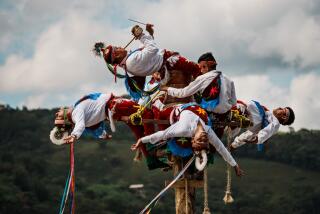OC HIGH / STUDENT NEWS AND VIEWS : On Edge : HANG-GLIDING : What’s it like to take it to the max? To plummet to earth in a parachute or on a bungee cord? To hang suspended from a glider? Here is what students who participate in such “daredevil” activities have to say about their experiences.
- Share via
Bryan Alfaro is afraid of heights. Tall buildings and cliffs make him nervous.
But he’ll gladly jump off one to hang-glide.
“I was nervous before I started, but they told me to run and take off,” Alfaro said. “And once I was in the air, all the fear left me.”
The junior at Sunny Hills High started hang-gliding a year ago after learning about the sport from his uncle.
Despite the fact that there is no barrier between the glider and rugged environment, Alfaro insists the sport is only dangerous if “you’re not thinking about what you’re doing.”
But to a non-glider, the sport is not exactly perceived to be a harmless hobby. “There’s always an element of danger,” he said. “But the worst thing that can happen is you can fall a little when you land.”
Careful assembly of the glider is key to avoiding injury.
“(The hang-glider) is like a kite,” Alfaro said. “You have to put it together.”
Hang-gliders fly in groups, and before taking off they all help put together the gliders.
“It’s not hard to put it together, but everyone takes their time,” Alfaro said. “And we double-check everything.”
To avoid bumping into buildings, hang-gliders fly in open terrain, over hills and valleys and maybe the sea.
The weather also determines how dangerous the flight will be, but hang-gliders, and especially beginners like Alfaro, won’t fly unless the sun’s shining and there is only a light breeze.
“If it’s really gusty, (the wind) can blow you into the mountain,” Alfaro said. “But you don’t fly when it’s windy.”
On the other hand, a bright day brings “thermals,” drafts of rising hot air. It is thermals that lift the glider after the takeoff.
“Hills and mountains have a lot of thermals,” Alfaro said.
With good thermals, a glider can fly around for hours. As the sun goes down, the thermals decrease, and the glider loses altitude.
This signifies that it’s time to land, a process much like landing a plane.
Without thermals, the glider will take off and promptly glide toward the ground.
Hang-gliders wear helmets, and tennis shoes are handy for the running takeoff. But other than that, there is no special equipment needed--except for a glider, which Alfaro said can be rented for about $50 per session.
As in other sports, it’s at the competitive level that expenses mount--transportation, high-tech equipment and time.
Experienced hang-gliders can enter endurance or acrobatic competitions. The former is a match to see who can stay in the air the longest, while the latter involves making loops and flying upside down.
“(Hang-gliders) can do anything an airplane can do,” Alfaro said.
However, in order to be a successful competitor, the glider must purchase a hang-glider built for endurance and another for acrobatics. These gliders generally have longer or thinner wings than the basic hang-glider.
Alfaro, who considers himself a beginner, said he enjoys the exhilaration of flying hundreds of feet above the earth, skimming over hills and oceans and taking in the smell of salt water.
“I think just doing it for recreation is good enough for right now.”
Jasmine Shoukry is a senior at Sunny Hills High School in Fullerton. This article first appeared in the school paper, The Accolade.
More to Read
Sign up for The Wild
We’ll help you find the best places to hike, bike and run, as well as the perfect silent spots for meditation and yoga.
You may occasionally receive promotional content from the Los Angeles Times.






